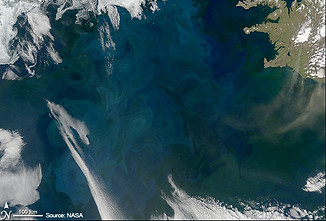
RESEARCH
My diverse research interests are unified by a focus on applying ecological theory, and defining the relationships between geochemical conditions and plankton community dynamics. I address my research questions with a skill set that includes experimental, observational, and modeling approaches.

Zooplankton and the biological carbon pump
Zooplankton play a key role in the ocean’s biological carbon pump–the suite of processes through which marine organisms mediate the export of carbon from the upper, sunlit ocean to depth. Changes in the biological carbon pump have implications for Earth’s biogeochemical cycles, and the fate of anthropogenic carbon dioxide. Both my dissertation and current post-doctoral research focus on the role of zooplankton in carbon and nutrient export.
Zooplankton produce rapidly-sinking fecal pellets, which can shuttle carbon deep into the ocean. This is called “passive flux.” They also breathe, or respire, all the time. Thus, when they migrate up and down in the water column, breathing, they actively transporting carbon in the form of carbon dioxide. We call this “active flux.” I have worked on modeling projects and conducted experiments to calculate passive and active carbon flux. I have also worked to understand how changes in zooplankton community composition, both in terms of species and size distribution, impacts the magnitude of these carbon fluxes.

Volcanic ash and marine primary production
In the ocean, phytoplankton production - also called primary production - is seasonally limited by the availability of macronutrients, mainly inorganic nitrogen. But in some parts of the ocean, primary production is limited by a lack of trace nutrients such as iron. This results in regions that are considered "high-nutrient, low-chlorophyll," or HNLC, meaning there is abundant nitrogen for phytoplankton growth, and yet, chlorophyll concentrations are still low because there is not enough iron for phytoplankton to grow and accumulate biomass.
Along with a team of geochemists and an optical oceanographer, I study how volcanic ash from fresh eruptions, and aged ash blown off of volcanoes from old eruptions can fertilize the Northeast Subarctic Pacific Ocean, a HNLC region, and increase primary productivity. As part of our work off of Alaska, we will engage with the Pribilof Island community of St. Paul, in the Bering Sea, to learn about volcanoes and the sea from indigenous people who have lived there for millenia. We also hope to share what we learn from our at-sea and laboratory experiments with them. We are grateful to the North Pacific Research Board for this opportunity!
Image of Mt. Redoubt from www.usgs.gov

Marine phenology
On land, changes in seasonality, or phenology, are some of the most evident impacts of the climate change: the weather, when leaves and flowers emerge in the spring, when birds depart in the fall, and so on. Changes in phenology have also been observed in the ocean. For example, the annual temperature cycle is changing making summers longer off of the Carolinas up to Nova Scotia. I use satellite data to look for changes in the seasonal cycle of phytoplankton populations, as well as the relationships between phytoplankton phenology, zooplankton and environmental factors like temperature.

Mixotrophy
Once thought a marine oddity, mixotrophy is now being recognized as a rule, rather than an exception. Mixotrophic organisms can both photosynthesize, and consume prey, to acquire energy. While there are few equivalents on land (for example, carnivorous plants), many aquatic plankton species are mixotrophic. I am interested in understanding what environmental conditions favor mixotrophs over organisms that just photosynthesize (phototrophs) or just eat other organisms (heterotrophs). This type of question requires lab experiments, data synthesis and modeling. It will lead to an understanding of how changing ocean conditions impact the flow of energy through the base of the marine food web.

North Atlantic right whales & their zooplankton prey
I study how the North Atlantic right whales’ prey impacts their population. The critically endangered North Atlantic right whale ranges between the southeastern U.S. coast, where it calves in the winter, and the waters off of New England and the Canadian Maritimes, where it feeds from late winter through autumn. The whales’ preferred prey is a lipid-rich copepod called Calanus finmarchicus, found in abundance in the Gulf of Maine and Gulf of St. Lawrence. Between 2008 and 2011 I co-led a long-term study of right whales and their prey. Based at the Provincetown Center for Coastal Studies, we set out once-to-multiple times per week between January and the end of May, sampling the waters of Cape Cod Bay for the right whales' crustacean prey. We not only documented changes in the zooplankton populations during this time; we also communicated directly with fishermen and state officials to prevent ship-strikes and entanglements of the whales: the two leading causes of right whale death.